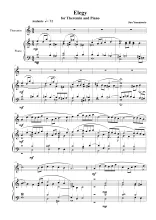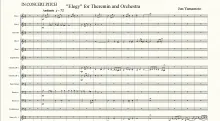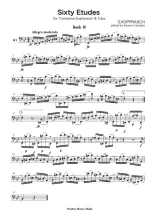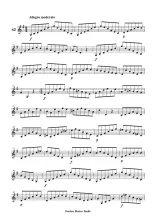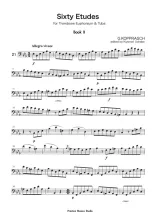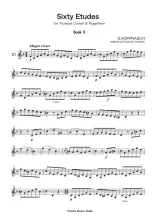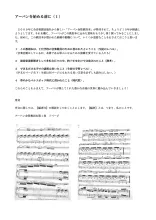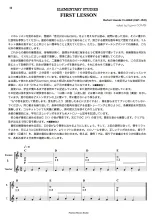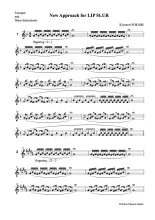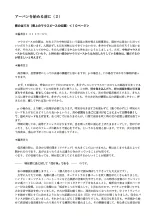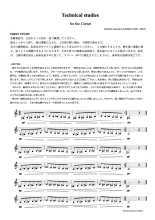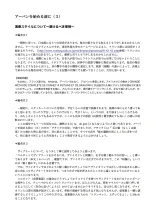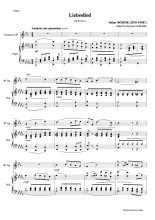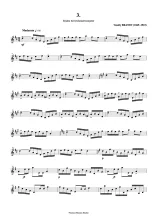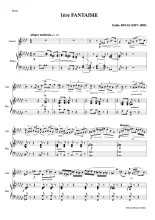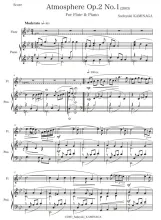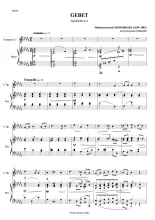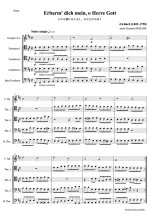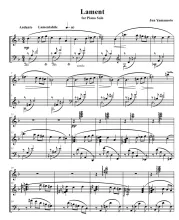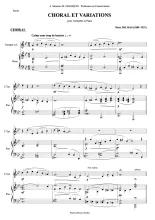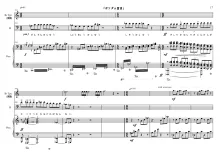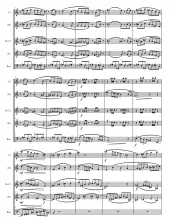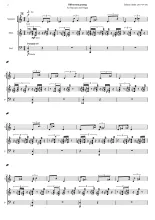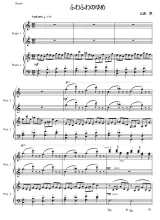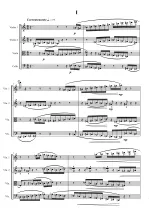New Releases
Our Staff Picks
News
"Potsdam Declaration"
YAMAMOTO, Jun山本準
The Potsdam Declaration is a surrender recommendation to Japan by the Allies led by the United States, announced on July 26, 1945, after Germany and Italy surrendered and the defeat of Japan became clearly unavoidable. There is no such humiliating document for us, Japanese, as defeated citizens, but the composer would like to revisit it, considering that it is a critical point of the modern history since Matthew Calbraith Perry's visit in Uraga, Japan, to require Japan to open a port for their whale hunting. The background of this Declaration includes, among others, the progress of the development of the atomic bomb in the United States (the President of the United States President Truman received a report of success of the experiment at Potsdam during the meeting period), the Far East policy of the Soviet Union, and plans and speculations of the Allies countries post-war power situation. While the “Declaration” describes democratic ideals, it reveals the power relationships and conflicts among all the super powers at the time. In composing, the composer focused on delivering the text to the audience as clearly as possible. With baritone’s text recitation, trumpet and piano play a role of shamisen against katari in Gidayu (although it is only an image). The text was translated from the original Declaration by the composer specifically for this composition. The text partly omits the original for clarity and musical requirements. The part following the text of the Potsdam Declaration is also the one that the composer transcribed from historical facts.
ポツダム宣言は独伊が降伏し日本の敗戦も決定的となった1945年7月26日に発表された、アメリカを中心とする、日本に対する降伏勧告である。敗戦国民であるわれわれ日本人にとってはこれほど屈辱的な文書もないが、ペリーの浦賀来航以来の近現代史の大きな結節点であると考え、改めて読み直してみたい。この宣言の背景には、米国の原子爆弾の開発の進捗(アメリカ大統領トルーマンはポツダム会談の期間中に現地でその実験成功の報せを受けたという)、ソ連の極東政策、戦後の米ソ間の力関係への両国の思惑などが絡み合い、一見民主主義的理想を述べているように見えながら、その裏には列強の利害と感情のぶつかり合いが透けてみえる。作曲に当たっては、あくまでもテキストを聴衆に伝えることに主眼を置いた。バリトンのテキスト朗唱に対し、トランペットとピアノは(あくまでイメージであるが)義太夫節の語りに対する三味線の役割を担う。テキストは英文原文から作曲者が新たに翻訳した。音楽上の要請から一部割愛・意訳した部分がある。ポツダム宣言本文に続く部分も史実から作曲者が書き起こしたものであり、文責は作曲者にある。
"Potsdam Declaration"
YAMAMOTO, Jun山本準
The Potsdam Declaration is a surrender recommendation to Japan by the Allies led by the United States, announced on July 26, 1945, after Germany and Italy surrendered and the defeat of Japan became clearly unavoidable. There is no such humiliating document for us, Japanese, as defeated citizens, but the composer would like to revisit it, considering that it is a critical point of the modern history since Matthew Calbraith Perry's visit in Uraga, Japan, to require Japan to open a port for their whale hunting. The background of this Declaration includes, among others, the progress of the development of the atomic bomb in the United States (the President of the United States President Truman received a report of success of the experiment at Potsdam during the meeting period), the Far East policy of the Soviet Union, and plans and speculations of the Allies countries post-war power situation. While the “Declaration” describes democratic ideals, it reveals the power relationships and conflicts among all the super powers at the time. In composing, the composer focused on delivering the text to the audience as clearly as possible. With baritone’s text recitation, trumpet and piano play a role of shamisen against katari in Gidayu (although it is only an image). The text was translated from the original Declaration by the composer specifically for this composition. The text partly omits the original for clarity and musical requirements. The part following the text of the Potsdam Declaration is also the one that the composer transcribed from historical facts.
ポツダム宣言は独伊が降伏し日本の敗戦も決定的となった1945年7月26日に発表された、アメリカを中心とする、日本に対する降伏勧告である。敗戦国民であるわれわれ日本人にとってはこれほど屈辱的な文書もないが、ペリーの浦賀来航以来の近現代史の大きな結節点であると考え、改めて読み直してみたい。この宣言の背景には、米国の原子爆弾の開発の進捗(アメリカ大統領トルーマンはポツダム会談の期間中に現地でその実験成功の報せを受けたという)、ソ連の極東政策、戦後の米ソ間の力関係への両国の思惑などが絡み合い、一見民主主義的理想を述べているように見えながら、その裏には列強の利害と感情のぶつかり合いが透けてみえる。作曲に当たっては、あくまでもテキストを聴衆に伝えることに主眼を置いた。バリトンのテキスト朗唱に対し、トランペットとピアノは(あくまでイメージであるが)義太夫節の語りに対する三味線の役割を担う。テキストは英文原文から作曲者が新たに翻訳した。音楽上の要請から一部割愛・意訳した部分がある。ポツダム宣言本文に続く部分も史実から作曲者が書き起こしたものであり、文責は作曲者にある。
"Potsdam Declaration"
YAMAMOTO, Jun山本準
The Potsdam Declaration is a surrender recommendation to Japan by the Allies led by the United States, announced on July 26, 1945, after Germany and Italy surrendered and the defeat of Japan became clearly unavoidable. There is no such humiliating document for us, Japanese, as defeated citizens, but the composer would like to revisit it, considering that it is a critical point of the modern history since Matthew Calbraith Perry's visit in Uraga, Japan, to require Japan to open a port for their whale hunting. The background of this Declaration includes, among others, the progress of the development of the atomic bomb in the United States (the President of the United States President Truman received a report of success of the experiment at Potsdam during the meeting period), the Far East policy of the Soviet Union, and plans and speculations of the Allies countries post-war power situation. While the “Declaration” describes democratic ideals, it reveals the power relationships and conflicts among all the super powers at the time. In composing, the composer focused on delivering the text to the audience as clearly as possible. With baritone’s text recitation, trumpet and piano play a role of shamisen against katari in Gidayu (although it is only an image). The text was translated from the original Declaration by the composer specifically for this composition. The text partly omits the original for clarity and musical requirements. The part following the text of the Potsdam Declaration is also the one that the composer transcribed from historical facts.
ポツダム宣言は独伊が降伏し日本の敗戦も決定的となった1945年7月26日に発表された、アメリカを中心とする、日本に対する降伏勧告である。敗戦国民であるわれわれ日本人にとってはこれほど屈辱的な文書もないが、ペリーの浦賀来航以来の近現代史の大きな結節点であると考え、改めて読み直してみたい。この宣言の背景には、米国の原子爆弾の開発の進捗(アメリカ大統領トルーマンはポツダム会談の期間中に現地でその実験成功の報せを受けたという)、ソ連の極東政策、戦後の米ソ間の力関係への両国の思惑などが絡み合い、一見民主主義的理想を述べているように見えながら、その裏には列強の利害と感情のぶつかり合いが透けてみえる。作曲に当たっては、あくまでもテキストを聴衆に伝えることに主眼を置いた。バリトンのテキスト朗唱に対し、トランペットとピアノは(あくまでイメージであるが)義太夫節の語りに対する三味線の役割を担う。テキストは英文原文から作曲者が新たに翻訳した。音楽上の要請から一部割愛・意訳した部分がある。ポツダム宣言本文に続く部分も史実から作曲者が書き起こしたものであり、文責は作曲者にある。
"Potsdam Declaration"
YAMAMOTO, Jun山本準
The Potsdam Declaration is a surrender recommendation to Japan by the Allies led by the United States, announced on July 26, 1945, after Germany and Italy surrendered and the defeat of Japan became clearly unavoidable. There is no such humiliating document for us, Japanese, as defeated citizens, but the composer would like to revisit it, considering that it is a critical point of the modern history since Matthew Calbraith Perry's visit in Uraga, Japan, to require Japan to open a port for their whale hunting. The background of this Declaration includes, among others, the progress of the development of the atomic bomb in the United States (the President of the United States President Truman received a report of success of the experiment at Potsdam during the meeting period), the Far East policy of the Soviet Union, and plans and speculations of the Allies countries post-war power situation. While the “Declaration” describes democratic ideals, it reveals the power relationships and conflicts among all the super powers at the time. In composing, the composer focused on delivering the text to the audience as clearly as possible. With baritone’s text recitation, trumpet and piano play a role of shamisen against katari in Gidayu (although it is only an image). The text was translated from the original Declaration by the composer specifically for this composition. The text partly omits the original for clarity and musical requirements. The part following the text of the Potsdam Declaration is also the one that the composer transcribed from historical facts.
ポツダム宣言は独伊が降伏し日本の敗戦も決定的となった1945年7月26日に発表された、アメリカを中心とする、日本に対する降伏勧告である。敗戦国民であるわれわれ日本人にとってはこれほど屈辱的な文書もないが、ペリーの浦賀来航以来の近現代史の大きな結節点であると考え、改めて読み直してみたい。この宣言の背景には、米国の原子爆弾の開発の進捗(アメリカ大統領トルーマンはポツダム会談の期間中に現地でその実験成功の報せを受けたという)、ソ連の極東政策、戦後の米ソ間の力関係への両国の思惑などが絡み合い、一見民主主義的理想を述べているように見えながら、その裏には列強の利害と感情のぶつかり合いが透けてみえる。作曲に当たっては、あくまでもテキストを聴衆に伝えることに主眼を置いた。バリトンのテキスト朗唱に対し、トランペットとピアノは(あくまでイメージであるが)義太夫節の語りに対する三味線の役割を担う。テキストは英文原文から作曲者が新たに翻訳した。音楽上の要請から一部割愛・意訳した部分がある。ポツダム宣言本文に続く部分も史実から作曲者が書き起こしたものであり、文責は作曲者にある。
"Potsdam Declaration"
YAMAMOTO, Jun山本準
The Potsdam Declaration is a surrender recommendation to Japan by the Allies led by the United States, announced on July 26, 1945, after Germany and Italy surrendered and the defeat of Japan became clearly unavoidable. There is no such humiliating document for us, Japanese, as defeated citizens, but the composer would like to revisit it, considering that it is a critical point of the modern history since Matthew Calbraith Perry's visit in Uraga, Japan, to require Japan to open a port for their whale hunting. The background of this Declaration includes, among others, the progress of the development of the atomic bomb in the United States (the President of the United States President Truman received a report of success of the experiment at Potsdam during the meeting period), the Far East policy of the Soviet Union, and plans and speculations of the Allies countries post-war power situation. While the “Declaration” describes democratic ideals, it reveals the power relationships and conflicts among all the super powers at the time. In composing, the composer focused on delivering the text to the audience as clearly as possible. With baritone’s text recitation, trumpet and piano play a role of shamisen against katari in Gidayu (although it is only an image). The text was translated from the original Declaration by the composer specifically for this composition. The text partly omits the original for clarity and musical requirements. The part following the text of the Potsdam Declaration is also the one that the composer transcribed from historical facts.
ポツダム宣言は独伊が降伏し日本の敗戦も決定的となった1945年7月26日に発表された、アメリカを中心とする、日本に対する降伏勧告である。敗戦国民であるわれわれ日本人にとってはこれほど屈辱的な文書もないが、ペリーの浦賀来航以来の近現代史の大きな結節点であると考え、改めて読み直してみたい。この宣言の背景には、米国の原子爆弾の開発の進捗(アメリカ大統領トルーマンはポツダム会談の期間中に現地でその実験成功の報せを受けたという)、ソ連の極東政策、戦後の米ソ間の力関係への両国の思惑などが絡み合い、一見民主主義的理想を述べているように見えながら、その裏には列強の利害と感情のぶつかり合いが透けてみえる。作曲に当たっては、あくまでもテキストを聴衆に伝えることに主眼を置いた。バリトンのテキスト朗唱に対し、トランペットとピアノは(あくまでイメージであるが)義太夫節の語りに対する三味線の役割を担う。テキストは英文原文から作曲者が新たに翻訳した。音楽上の要請から一部割愛・意訳した部分がある。ポツダム宣言本文に続く部分も史実から作曲者が書き起こしたものであり、文責は作曲者にある。
"Potsdam Declaration"
YAMAMOTO, Jun山本準
The Potsdam Declaration is a surrender recommendation to Japan by the Allies led by the United States, announced on July 26, 1945, after Germany and Italy surrendered and the defeat of Japan became clearly unavoidable. There is no such humiliating document for us, Japanese, as defeated citizens, but the composer would like to revisit it, considering that it is a critical point of the modern history since Matthew Calbraith Perry's visit in Uraga, Japan, to require Japan to open a port for their whale hunting. The background of this Declaration includes, among others, the progress of the development of the atomic bomb in the United States (the President of the United States President Truman received a report of success of the experiment at Potsdam during the meeting period), the Far East policy of the Soviet Union, and plans and speculations of the Allies countries post-war power situation. While the “Declaration” describes democratic ideals, it reveals the power relationships and conflicts among all the super powers at the time. In composing, the composer focused on delivering the text to the audience as clearly as possible. With baritone’s text recitation, trumpet and piano play a role of shamisen against katari in Gidayu (although it is only an image). The text was translated from the original Declaration by the composer specifically for this composition. The text partly omits the original for clarity and musical requirements. The part following the text of the Potsdam Declaration is also the one that the composer transcribed from historical facts.
ポツダム宣言は独伊が降伏し日本の敗戦も決定的となった1945年7月26日に発表された、アメリカを中心とする、日本に対する降伏勧告である。敗戦国民であるわれわれ日本人にとってはこれほど屈辱的な文書もないが、ペリーの浦賀来航以来の近現代史の大きな結節点であると考え、改めて読み直してみたい。この宣言の背景には、米国の原子爆弾の開発の進捗(アメリカ大統領トルーマンはポツダム会談の期間中に現地でその実験成功の報せを受けたという)、ソ連の極東政策、戦後の米ソ間の力関係への両国の思惑などが絡み合い、一見民主主義的理想を述べているように見えながら、その裏には列強の利害と感情のぶつかり合いが透けてみえる。作曲に当たっては、あくまでもテキストを聴衆に伝えることに主眼を置いた。バリトンのテキスト朗唱に対し、トランペットとピアノは(あくまでイメージであるが)義太夫節の語りに対する三味線の役割を担う。テキストは英文原文から作曲者が新たに翻訳した。音楽上の要請から一部割愛・意訳した部分がある。ポツダム宣言本文に続く部分も史実から作曲者が書き起こしたものであり、文責は作曲者にある。
Capriccio for flute, oboe, clarinet, french horn, and fagot
YAMAMOTO, Jun山本準
The composer intended to take advantage of the rich expressive ability and agility of wind wood instruments to the maximum in this composition, which consists of loosely 3 parts. Begins with a rhythmic and somewhat humorous theme (A) and a melodic theme (B) and repeats them in different instrumentation. After the third repetition of (A), the middle part starts with a new theme by Horn on the fast passage exchange of Oboe and Clarinet (D). Then tempo is slowed down to Adagiette. Oboe and Clarinet takes solos and the (D) part comes back. After a fast unison phrases, the themes are developed contrapuntally and the music rush into the Coda.
木管楽器の優れた運動性と豊かな表情を最大限に生かしたいと考えて作曲された。曲はゆるやかな3部形式をとる。冒頭にAllegrettoでリズミカルなテーマ(A)とメロディックなテーマ(B)が提示され、形を変えて二回繰り返される。再度パートを交換して(A)が提示されて中間部に入る。Vivaceでオーボエとクラリネットの早い音階のパッセージの交換にのせてホルンが新しいテーマを導入する(C)。続いて、緩徐部分(Adagietto)となり、オーボエ、クラリネットの順にソロを展開し、もう一度速い(D)が再帰する。やや速度を落としてユニゾンのパッセージから、対位法的な展開を経て(A)(B)が再現し、他の要素も含めて速度を上げて展開され、一気にコーダに達する。
Diffraction grating
IKEDA, Takumi池田拓実
First performed by:
Masako Shindo, Soprano
Minako Tsukatatani, Organ
at Reinanzaka Church, Tokyo on 21 July 2017.
Duration: ca. 10 min.
初演:
新藤昌子(ソプラノ)
塚谷水無子(オルガン)
2017年7月21日 霊南坂教会
演奏時間:約10分
Diffraction grating
IKEDA, Takumi池田拓実
First performed by:
Masako Shindo, Soprano
Minako Tsukatatani, Organ
at Reinanzaka Church, Tokyo on 21 July 2017.
Duration: ca. 10 min.
初演:
新藤昌子(ソプラノ)
塚谷水無子(オルガン)
2017年7月21日 霊南坂教会
演奏時間:約10分
Lament for solo piano
YAMAMOTO, Jun山本準
This small piece for solo piano has been composed in 1985.
このピアノの小品は1985年に作曲された。
A Fluffy Dream for 4-hand piano
YAMAMOTO, Jun山本準
A short 4-hand piano piece for children, "A Dream Fluffy", has been premiered on July 30, 2017, in Kumamoto, Japan.
子どものためのピアノ連弾曲「ふわふわの夢」は、2017年7月30日(日)に「こどもたちへのメッセージ in 熊本」にて初演されました。
Three Arabesques for String Quartet
YAMAMOTO, Jun山本準
The composition consists of 3 movements.
The 1st movement (Correntmente): Wave-like figures based on 6 sixteenth notes weaves the music with attacks having intervals of 3 sixteenth and 2 sixteenth. At the coda, the music become calm and slow to bridge through the next movement.
The 2nd movement (Tranquillo): The music starts with a calm movement with sordino. The two units, namely 1st violin and viola and 2nd violin and violoncello, constructs the music with constant interval in rhythms.
The 3rd movement (Allegro energico): Closely positioned tremolo and harsh rhythms starts the music. The main part is a combination of tremolo and pizzicato. The music recollect the motives in the 1st and 2nd movement and reaches the coda.
"Three Arabesques for String Quartet" has premiered by the Precious Quartet (Erina Kato, Nina Furukawa, Saori Oka, and Kazuhisa Ogawa) in Sumida Triphony Hall, Tokyo, Japan, on May 15, 2017.
「3つのアラベスク~弦楽四重奏のための」は3つの楽章から構成される。
第一楽章 Correntemente 波打ちながら連続する16分音符6つを単位とする流れを中心として、これに附点8分音符および8分音符を単位とするリズムが交錯する。コーダは速度を落とし、Tranquillo となって第二楽章への導入となる。
第二楽章 Tranquillo 弱音器を付した静かな楽想から始まり、第一ヴァイオリンとヴイオラ、第二ヴァイオリンとチェロの組み合わせによる二つのユニットが互いに相反するリズムで音楽を織り上げていく。
第三楽章 Allegro energico 密集した和音のトレモロに合わせて、激しいリズムをもつ音形が提示され、続いてトレモロとピチカートの組み合わせによる主部に導かれる。中間部はやや速度を落として冒頭の音形とピチカートが組み合わされる。前二楽章の短い回想と冒頭のモチーフの再現を経て、コーダにいたる。
本作品は2017年5月15日、東京のすみだトリフォニーホール小ホールにて、プレシャス・カルテット(第一ヴァイオリン 加藤えりな、第二ヴァイオリン 古川仁菜、ヴィオラ 岡さおり、チェロ 小川和久)により初演された。
